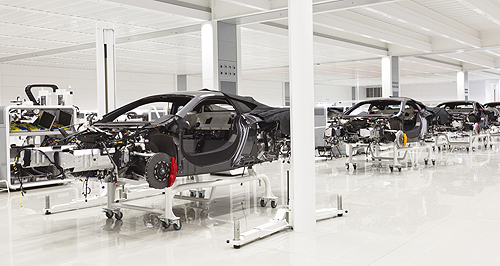News - McLarenMcLaren caps production at 5000 until 2022Capped: McLaren’s production facility in Woking, UK, will produce between 4000-5000 per year for the next few years. No SUV and EV unlikely as McLaren finds profitability sweet spot14 May 2018 MCLAREN will peg its annual production volume at between 4000 and 5000 units until 2022, with its fast and sharp growth now being deliberately tapered off due to increased profitability.
Having started production in 2011, the London-based sportscar manufacturer produced 1654 units in 2015 before quickly doubling to 3340 last year when it challenged Lamborghini (3815), if not Ferrari (8398).
However, according to McLaren global communications director Wayne Bruce, the car-maker has reached a ‘sweet spot’ between volume and profitability that requires no major increase over the next four years despite new models arriving.
“Last year it was 3300 cars globally, this year we look set to break 4000 cars, but by the end of the decade we’re very happy hovering between 4000 and 5000 cars per year,” Mr Bruce told GoAuto at a drive day with the McLaren 540C and 570S Spider in Sydney last week.
“We became profitable when we passed 1500 cars which was four years ago, we introduced a second shift at our factory last year which was to capacitise us to get to 20 cars per day – which is what leads us to this volume of between 4000 and 5000 cars per year.
“It’s a balance with a luxury brand between supply and demand, and there’s no right or wrong answer, but we feel for our customers that’s about the right volume. Our customers don’t wish to see a McLaren on every street corner, and so it will continue to be this mix of limited production cars – that thus far have sold out before we started production of them – and series production cars.
“It gives us a return to keep investing in cars, which gives us a sustainable business.”
Mr Bruce said that, as part of the McLaren’s Track22 strategic plan until the end of 2022, it is re-investing a substantial amount of its annual turnover back into new model development.
That will include one new vehicle or derivative per year, with the 720S, 570S Spider and Senna having been shown so far. But others might not include an electric vehicle (EV) and will not – as previously reported – include a sporty SUV.
“We invest about 20 to 25 per cent of our turnover back into the future product, which adds up to about £1 billion over the (Track22) business plan (until 2022),” he continued.
“Your typical company, whether they’re making water bottles of telephones, re-invest between seven and eight per cent into future product. But for us it’s higher because new cars are our lifeblood.
“By the end of the business plan in 2022 at least half our cars are going to be hybrid. The P1 was a hybrid and we’re going to be doing many more – (but) electric cars is something that’s troubling us. We think in the future everyone is going to be in an electric car, hopefully not too soon, it could be five or 10 or 20 years.
“We are working on one (but) challenges for engineers are not least how customers use their cars. So Mr and Mrs McLaren will leave home in the morning, they will do half an hour (racing), watch the fuel tank go down, someone else fills the car up for them, back on the track again … the car’s fuelled up and they drive home. With current battery technology you cannot do that. We also cannot make a McLaren electric vehicle today that is going to weigh less than two tonnes and we are not going to do that. So don’t look out for a McLaren EV anytime soon.”
Although rival Lamborghini has flagged that its production of 3815 units in 2017 will double in 2018 thanks to the arrival of the Urus SUV, Mr Bruce reiterated that McLaren has no demand or desire to build one.
“We’ve got no space to make an SUV, and we have no desire to make an SUV,” he said.
“If you come with us down to Woking (London headquarters) and down to the directors’ carpark you’ll see many Defenders and Ranger Rovers – they do a better job of it than we ever could, so we’ll leave that to Land Rover. But most importantly our customers are not asking us for a McLaren SUV.”
McLaren will focus on producing small-volume, limited-edition supercars such as the Senna and BP23, which have seen global demand exceed slated production runs by a factor of around three.
McLaren sold 116 vehicles in Australia last year, growing from 92 in 2016 and 36 in 2015. Mr Bruce confirmed that the latest figures showed an even number of local buyers were purchasing the 540C/570S/570GT and the flagship 720S compared with a 60:40 production split favouring the cheaper models globally.
“However we expect now that 570S Spider is coming on stream it should go back towards two-thirds (540C/570S/570GT) to one-third (720S),” Mr Bruce added.
“It was helped I think by the fact the 720S was in its launch year. We think Australia will grow a little bit this year in line with our global markets (but) maybe not even (to 120 cars).”  Read more8th of February 2018  Geneva show: McLaren reveals additional Senna detailsPerformance figures and aerodynamic abilities of Senna detailed by McLaren12th of January 2018  McLaren updates Sports Series rangePrice rises, additional equipment and choice for McLaren Sports Series range11th of December 2017  McLaren hypercar takes Senna nameBrutal Senna hypercar to be the most powerful road-legal McLaren yet |
Click to shareMcLaren articlesMotor industry news |
















Facebook Twitter Instagram